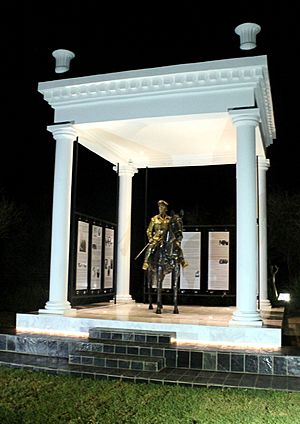Jan Smuts facts for kids
Quick facts for kids
Jan Christiaan Smuts
|
|
|---|---|
 |
|
| 4th Prime Minister of South Africa | |
| In office 5 September 1939 – 4 June 1948 |
|
| Monarch | George VI |
| Governor-General | Sir Patrick Duncan Nicolaas Jacobus de Wet (Acting) Gideon Brand van Zyl |
| Preceded by | James Barry Munnik Hertzog |
| Succeeded by | Daniel François Malan |
| 2nd Prime Minister of South Africa | |
| In office 3 September 1919 – 30 June 1924 |
|
| Monarch | George V |
| Governor-General | The Earl of Buxton The Prince Arthur of Connaught The Earl of Athlone |
| Preceded by | Louis Botha |
| Succeeded by | James Barry Munnik Hertzog |
| Personal details | |
| Born | 24 May 1870 Bovenplaats, Cape Colony |
| Died | 11 September 1950 (aged 80) Doornkloof, Irene, Transvaal Province, Union of South Africa |
| Political party | South African Party United Party |
| Spouse | Issie Krige |
| Signature |  |
Jan Christiaan Smuts (born May 24, 1870 – died September 11, 1950) was a very important South African soldier and politician. He served as the Prime Minister of South Africa twice. His first term was from 1919 to 1924, and his second was from 1939 to 1948. Smuts played a big role in shaping South Africa and was also involved in major world events like both World War I and World War II.
Contents
Jan Smuts: A Life of Leadership
Growing Up in South Africa
Jan Smuts was born into a wealthy Afrikaner family. They lived in the Cape Colony, which was then under British rule. He started school when he was 12 years old. Four years later, he went to Victoria College to study science and the arts. Later, he traveled to England to study law at Christ's College in Cambridge.
The Boer War and South Africa's Unity
Smuts first supported Cecil Rhodes, a well-known British politician in South Africa. However, Smuts stopped supporting Rhodes when it was found that Rhodes was involved in the Jameson Raid. This raid was an attempt by a group of foreigners (called Uitlanders) to take control in the Transvaal Republic.
In 1898, Smuts moved to Johannesburg in the Transvaal to work as a lawyer. He later became a minister in the Transvaal government. This was until the Anglo-Boer War began.
During the Boer War, Smuts led a Boer Commando unit. They used guerrilla tactics in the Cape Colony. After the war, Smuts joined the government led by Louis Botha in 1907. However, he felt uneasy about his Afrikaner friends working with the British. A year later, he decided to no longer identify only as Afrikaner, saying he was South African instead.
Soldier and Statesman
Two years after the Union of South Africa was formed, Smuts created the Union Defence Force (UDF). He led the UDF and was very important in helping South Africa take control of German South-West Africa and German East Africa during World War I.
In 1917, Smuts was asked to join the Imperial War Cabinet in Britain. In 1918, he also helped create the Royal Air Force, which is the air force of the United Kingdom.
Smuts and Botha were key negotiators at the Paris Peace Conference after World War I. After signing the Treaty of Versailles, which gave South Africa control over Namibia, Smuts returned to politics.
When Botha died in 1919, Smuts became Prime Minister. He served until 1924, when he lost the election to the National Party.
Leading During World War II
After being out of power for nine years, Smuts became Deputy Prime Minister in a government led by Barry Hertzog. When Hertzog wanted South Africa to stay neutral towards Nazi Germany during World War II, he was removed from office. Smuts then became Prime Minister again.
During World War II, Smuts was again invited to the Imperial War Cabinet. There, he worked closely with British Prime Minister Winston Churchill. On May 28, 1941, Smuts became a Field Marshal of the British Army. He was the first South African to hold this high rank. His close work with Churchill made Smuts very unpopular with many Afrikaners, which later led to his political defeat.
In May 1945, Smuts represented South Africa when the United Nations Charter was being written. Just like he did in 1919, Smuts urged the delegates to create a strong international organization to keep peace in the world. Smuts signed the Paris Peace Treaty after World War II. This made him the only person to sign the treaties that ended both the First and Second World Wars.
After the Second World War
After World War II, Smuts continued to represent South Africa on the world stage. However, his support for the war and his ideas about changing racial segregation in South Africa made him very unpopular with many Afrikaners. In 1948, he lost the election to Daniel Francois Malan and the National Party, which supported Apartheid.
Jan Smuts died on September 11, 1950, from a heart attack. He passed away on his family farm.
See also
 In Spanish: Jan Smuts para niños
In Spanish: Jan Smuts para niños



